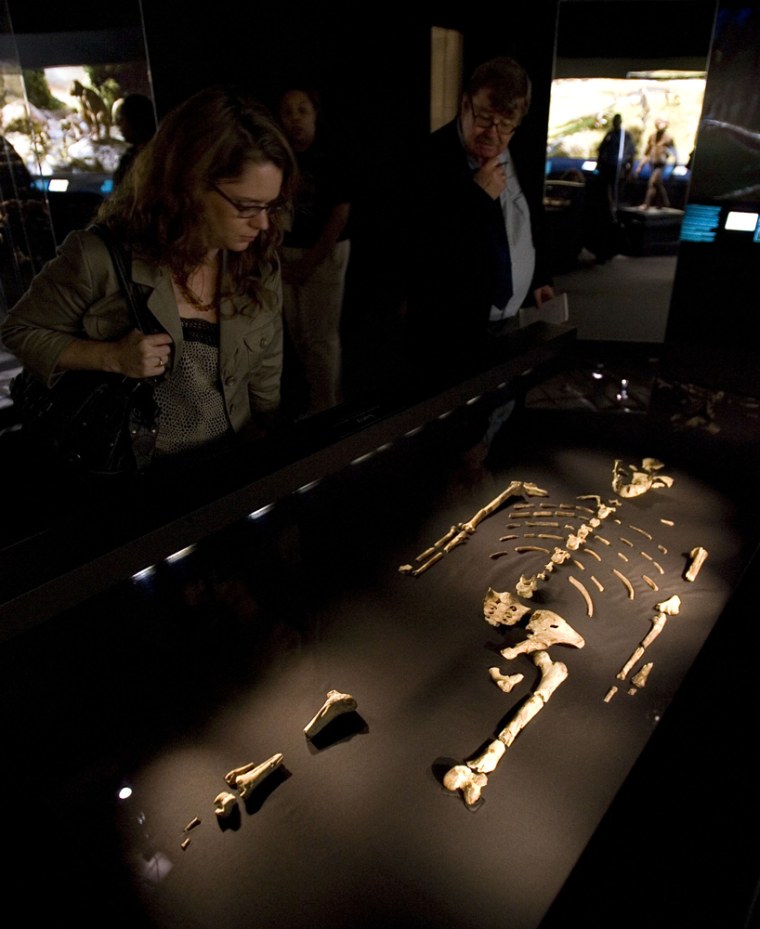After six years of planning and negotiations, and a controversy reverberating through the scientific community, the world's most famous fossil made her public debut Tuesday.
Lucy, a 3.2 million-year-old Australopithecus afarensis, was unveiled during a media preview at the Houston Museum of Natural Science, where she will be the centerpiece of an exhibit opening Friday.
"Lucy's Legacy: The Hidden Treasures of Ethiopia" features more than 150 religious and cultural artifacts from Ethiopia — a part of the exhibit that museum officials and the Ethiopian government worry may be overshadowed by the furor surrounding Lucy.
The decision to bring Lucy to Houston for public exhibit spurred outrage among the world's most noted paleoanthropologists, who say the fragile fossil could be irreparably damaged by the travel to Houston and a subsequent six-year tour.
The Houston exhibit marks the first time Lucy has been displayed in public outside Ethiopia, where she has been exhibited only twice.
About half of the exhibit is devoted to telling nearly 3,000 years of Ethiopian history, starting with the ancient Aksum civilization in the first century A.D. and ending with the reign of Emperor Haile Selassie in 1974, the year Lucy was discovered.
"It offers two — not one — grand narratives, two grand narratives that originate in Ethiopia," Samuel Assefa, the Ethiopian ambassador to the United States, said at a press conference following the preview. "First, of course, is the evolution of man, and the second is Ethiopia as one of the cradles of civilization. We see this as a wonderful opportunity to make known to the world who we are."
Ethiopian government officials hope the exhibit will spark tourism in Ethiopia, and dispel the image of the country as a war-torn, famine-plagued land.
But Lucy is indeed the star of this show.
After passing through the rooms devoted to Ethiopian history, exhibitgoers enter three dimly lit chambers. In the first two, the exhibit focuses on the prehistoric era and asks: What is our origin? What is our purpose?

In the third, a darkened circular room, they meet Lucy.
Her skeleton, lying flat inside a sleek glass and black case, is dusted by soft lighting. Around her, a 78-foot-long (24-meter-long) mural tells the story of 6 million years of human evolution. Near the fossil, a life-size model of what Lucy might have looked like stands encased in her own glass enclosure, looking at the viewer with a half-smile.
Lucy, a hominid fossil named after the Beatles' song "Lucy in the Sky with Diamonds," was discovered in the remote Afar province in northeastern Ethiopia. Although not the oldest human ancestor ever found, her skeleton is among the most complete, with about 40 percent of her bones intact. She likely weighed about 60 pounds (27 kilograms) and stood about 3.5 feet (1 meter) tall.
With the discovery of Lucy, scientists were first able to establish that human ancestors walked upright before evolving a big brain.
"She is the world's most famous fossil, and she continues to profoundly influence our understanding of human origins," said Dirk Van Tuerenhout, the Houston museum's curator of anthropology. "Lucy is not only part of Ethiopia's cultural heritage, she is part of the world's heritage, and she deserves to be on the world stage for all to see."
